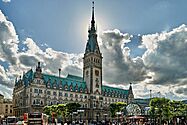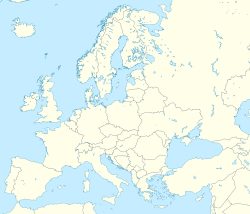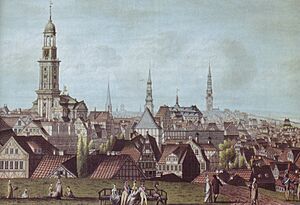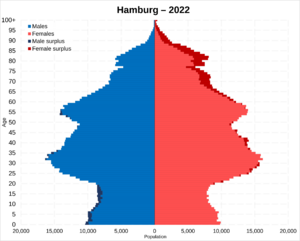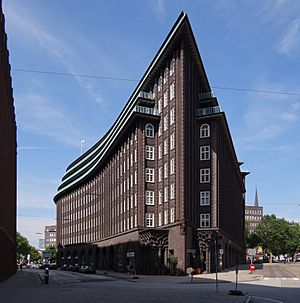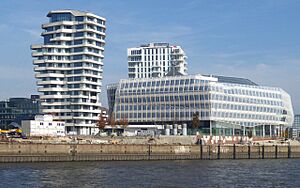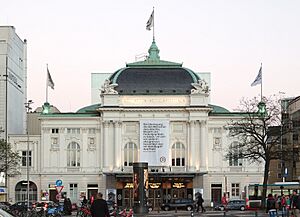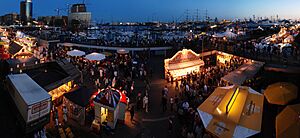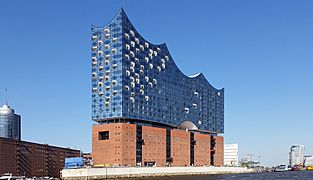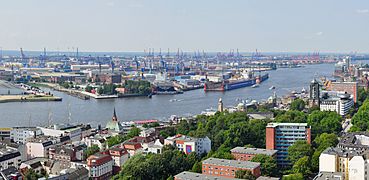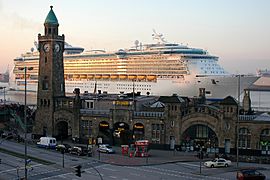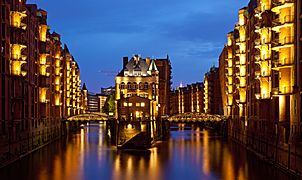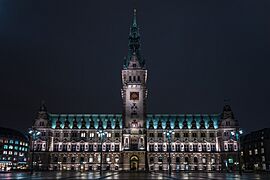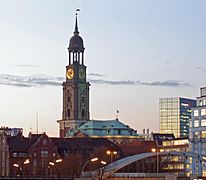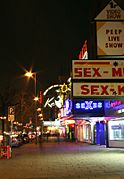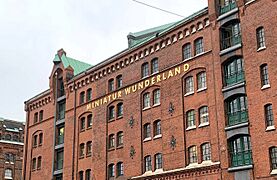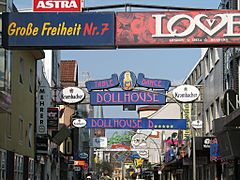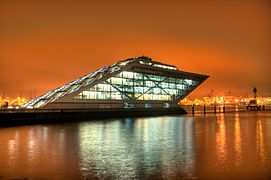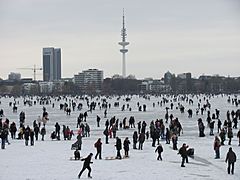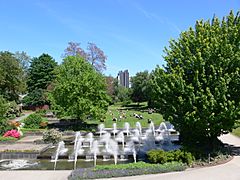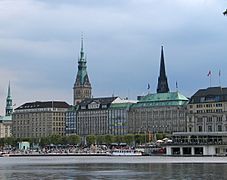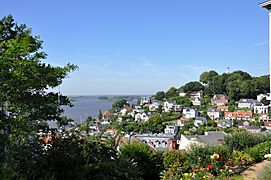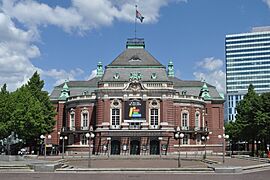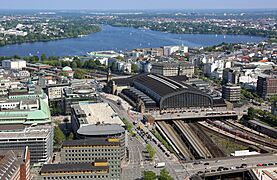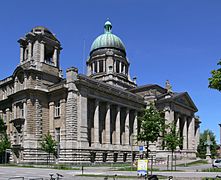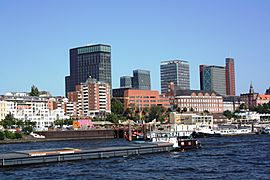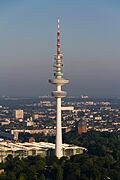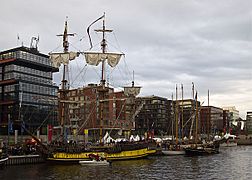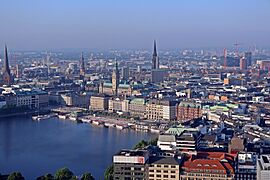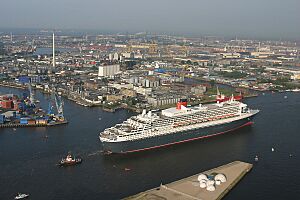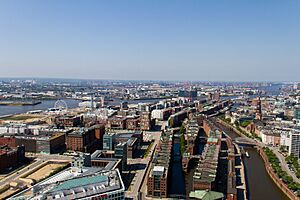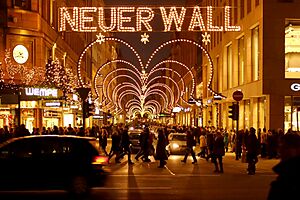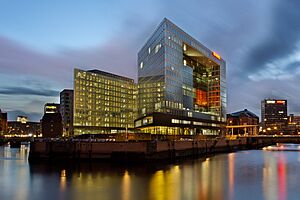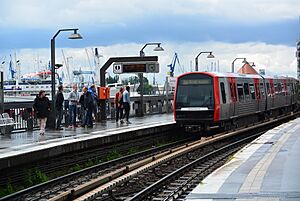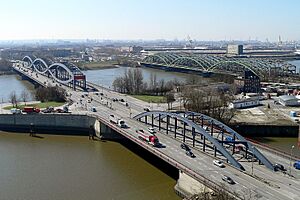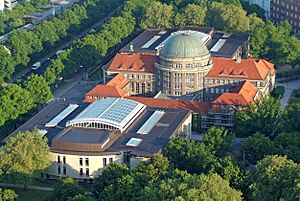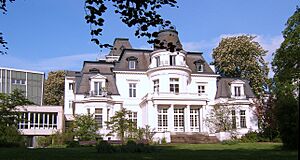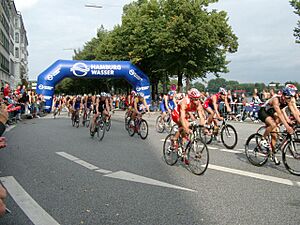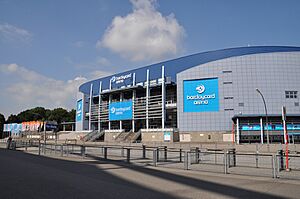Hamburg facts for kids
Quick facts for kids
Hamburg
Hamborg (Low German)
|
|||||
|---|---|---|---|---|---|
|
Municipality and state
|
|||||
| Free and Hanseatic City of Hamburg | |||||
|
Inner Alster Lake at dusk
St. Pauli Piers
HafenCity
Speicherstadt
Elbe Philharmonic Hall
St. Michael's Church
City hall
|
|||||
|
|||||

Hamburg highlighted in Germany
|
|||||
| Country | Germany | ||||
| Government | |||||
| • Body | Hamburg Parliament | ||||
| Area | |||||
| • City | 755.22 km2 (291.59 sq mi) | ||||
| Population
(1772100)
|
|||||
| • City | 1,772,100 | ||||
| • Density | 2,346.47/km2 (6,077.33/sq mi) | ||||
| • Urban | 2,496,600 | ||||
| • Metro | 5,425,628 | ||||
| Demonym(s) | German: Hamburger (male), Hamburgerin (female) English: Hamburger(s), Hamburgian(s) |
||||
| GDP | |||||
| • City | €144.220 billion (2022) | ||||
| • Per capita | €76,910 (2022) | ||||
| Time zone | UTC+1 (Central (CET)) | ||||
| • Summer (DST) | UTC+2 (Central (CEST)) | ||||
| Postal code(s) |
20001–21149, 22001–22769
|
||||
| Area code(s) | 040 | ||||
| ISO 3166 code | DE-HH | ||||
| Vehicle registration |
|
||||
| NUTS Region | DE6 | ||||
| HDI (2021) | 0.972 very high · 1st of 16 |
||||
| Website | hamburg.com | ||||
Hamburg is Germany's second-largest city. It is also the sixth-largest city in the European Union. Over 1.9 million people live here. The wider Hamburg area, called the Hamburg Metropolitan Region, has more than 5.1 million people.
Hamburg is located on the River Elbe. This river flows into the North Sea. The city is also near the mouths of the Alster and Bille rivers. Hamburg is one of Germany's three "city-states," like Berlin and Bremen. It is surrounded by the states of Schleswig-Holstein and Lower Saxony.
The Port of Hamburg is Germany's biggest port. It is also the third-largest in Europe. The city's official name, "Free and Hanseatic City of Hamburg," shows its long history. It was part of the Hanseatic League, a group of trading cities in the Middle Ages. It was also a free city in the Holy Roman Empire.
Hamburg has faced many challenges, like big fires and wars. But it has always recovered and grown stronger. Today, it is a major center for media, business, and science. Many important companies and universities are based here. Hamburg is also a popular place for tourists. It has many bridges, old buildings, and famous concert halls like the Elbe Philharmonic Hall.
Contents
- Discovering Hamburg's Past
- Hamburg's Location and Weather
- People and Cultures of Hamburg
- Hamburg's Cityscape and Landmarks
- Hamburg's Vibrant Culture
- Main Sights to See
- Hamburg's Economy and Business
- Getting Around Hamburg
- Learning and Education in Hamburg
- Sports in Hamburg
- Sister Cities
- Famous People from Hamburg
- Images for kids
- See also
Discovering Hamburg's Past
How Hamburg Began
The name Hamburg comes from a castle built in 808 AD. Emperor Charlemagne ordered it built to defend against invaders. This castle was called Hammaburg, meaning "castle on the Hamma." The exact meaning of "Hamma" is still a bit of a mystery.
Hamburg in Medieval Times
In 834, Hamburg became the seat of a bishop. The first bishop, Ansgar, was known as the "Apostle of the North." Hamburg was attacked and destroyed many times. In 845, Viking ships sailed up the Elbe River and destroyed the town. Later, in 1030, the Polish King Mieszko II Lambert burned the city.
In 1189, Emperor Frederick I "Barbarossa" gave Hamburg special rights. It became a Free Imperial City. This meant it could trade freely on the Elbe River. This helped Hamburg become a major port. In 1241, Hamburg joined with Lübeck to form the Hanseatic League. This was a powerful group of trading cities.
In 1350, the Black Death caused many deaths in Hamburg. The city also had several big fires during the medieval period.
Early Modern History
In 1529, Hamburg became a Lutheran city. It welcomed refugees from the Netherlands and France. In the 1600s, new defenses were built around the city. This created a "New Town" (Neustadt). Its street names still show the old grid system.
After the Holy Roman Empire ended in 1806, Hamburg became a fully independent state. It was called the "Free and Hanseatic City of Hamburg." For a short time, Napoleon I took control of Hamburg. But Russian forces freed the city in 1814. Hamburg then rejoined the German Confederation.
In 1842, a "Great Fire" destroyed about a quarter of the inner city. It burned for four days. Many buildings were lost, and 51 people died. About 20,000 people lost their homes. It took over 40 years to rebuild the city.
Hamburg grew very fast in the late 1800s. Its population more than quadrupled. This was because of its growing trade with the Atlantic. The Hamburg America Line became the world's largest shipping company. Many people from Germany and Eastern Europe left for the United States from Hamburg's port.
Hamburg in World War II

During World War II, Hamburg was heavily bombed by the Allies. In July 1943, a firebombing raid created a huge firestorm. This destroyed large parts of the city. At least 42,600 civilians died. About one million people were moved out of the city for safety.
Many people also died in the Neuengamme concentration camp nearby. Jewish people living in Hamburg were forced to leave their homes. Most of them died in the the Holocaust.
After the War
Hamburg was given to British Forces in May 1945. After the war, it became a state of West Germany in 1949.
In 1962, a big flood from the North Sea caused the Elbe River to rise very high. One-fifth of Hamburg was flooded, and over 300 people died.
For a long time, Hamburg was close to the inner German border. This border separated the city from much of its surrounding area. After German reunification in 1990, Hamburg's port began to grow again. It aimed to become a major trading center once more.
Hamburg's Location and Weather
Hamburg has a safe, natural harbor. It is located where the Jutland Peninsula begins. This is between Continental Europe and Scandinavia. The North Sea is to the west, and the Baltic Sea is to the northeast. The city center is around the Binnenalster and Außenalster lakes. These lakes were made by damming the River Alster.
Some parts of Hamburg, like Neuenfelde and Cranz, are in the Altes Land region. This is Central Europe's largest fruit-growing area. Hamburg's highest point is the Hasselbrack, which is 116.2 meters (381 feet) above sea level. Hamburg shares borders with the German states of Schleswig-Holstein and Lower Saxony.
What is Hamburg's Climate Like?
Hamburg has an oceanic climate. This means it is influenced by the nearby coast and the Atlantic Ocean. Winters are usually mild, and summers are cool. Snowfall varies a lot each year.
The warmest months are June, July, and August. High temperatures are usually between 20.1°C and 22.5°C (68.2°F and 72.5°F). The coldest months are December, January, and February. Low temperatures are typically between -0.3°C and 1.0°C (31.5°F and 33.8°F).
| Climate data for Hamburg-Fuhlsbuttel (Hamburg Airport), elevation: 15 m, 1991–2020 normals) | |||||||||||||
|---|---|---|---|---|---|---|---|---|---|---|---|---|---|
| Month | Jan | Feb | Mar | Apr | May | Jun | Jul | Aug | Sep | Oct | Nov | Dec | Year |
| Record high °C (°F) | 14.4 (57.9) |
17.2 (63.0) |
23.0 (73.4) |
29.7 (85.5) |
33.5 (92.3) |
34.6 (94.3) |
40.1 (104.2) |
37.3 (99.1) |
32.3 (90.1) |
26.1 (79.0) |
20.2 (68.4) |
15.7 (60.3) |
40.1 (104.2) |
| Mean daily maximum °C (°F) | 4.2 (39.6) |
5.2 (41.4) |
8.7 (47.7) |
13.9 (57.0) |
18.0 (64.4) |
20.9 (69.6) |
23.2 (73.8) |
23.0 (73.4) |
18.8 (65.8) |
13.6 (56.5) |
8.2 (46.8) |
5.0 (41.0) |
13.6 (56.5) |
| Daily mean °C (°F) | 2.1 (35.8) |
2.4 (36.3) |
4.9 (40.8) |
9.1 (48.4) |
13.0 (55.4) |
16.0 (60.8) |
18.3 (64.9) |
18.0 (64.4) |
14.4 (57.9) |
10.0 (50.0) |
5.7 (42.3) |
2.9 (37.2) |
9.7 (49.5) |
| Mean daily minimum °C (°F) | −0.5 (31.1) |
−0.5 (31.1) |
1.1 (34.0) |
4.0 (39.2) |
7.6 (45.7) |
10.8 (51.4) |
13.3 (55.9) |
13.1 (55.6) |
10.1 (50.2) |
6.3 (43.3) |
2.9 (37.2) |
0.4 (32.7) |
5.7 (42.3) |
| Record low °C (°F) | −22.8 (−9.0) |
−29.1 (−20.4) |
−15.3 (4.5) |
−7.1 (19.2) |
−5.0 (23.0) |
0.6 (33.1) |
3.4 (38.1) |
1.8 (35.2) |
−1.2 (29.8) |
−7.1 (19.2) |
−15.4 (4.3) |
−18.5 (−1.3) |
−29.1 (−20.4) |
| Average precipitation mm (inches) | 66.7 (2.63) |
54.9 (2.16) |
56.7 (2.23) |
39.2 (1.54) |
57.8 (2.28) |
74.4 (2.93) |
81.8 (3.22) |
77.5 (3.05) |
64.7 (2.55) |
63.0 (2.48) |
61.1 (2.41) |
72.6 (2.86) |
770.5 (30.33) |
| Average precipitation days (≥ 1.0 mm) | 17.7 | 16.2 | 15.2 | 12.8 | 13.8 | 15.3 | 16.0 | 15.8 | 14.5 | 16.2 | 16.9 | 18.0 | 188.4 |
| Average snowy days (≥ 1.0 cm) | 5.9 | 5.0 | 2.9 | 0 | 0 | 0 | 0 | 0 | 0 | 0 | 1.2 | 3.5 | 18.5 |
| Average relative humidity (%) | 85.8 | 82.6 | 77.7 | 71.0 | 70.8 | 72.1 | 72.6 | 74.3 | 79.4 | 83.4 | 87.1 | 87.6 | 78.7 |
| Mean monthly sunshine hours | 44.9 | 66.8 | 119.9 | 182.8 | 221.2 | 210.3 | 218.8 | 202.7 | 152.4 | 109.3 | 51.4 | 36.1 | 1,616.7 |
| Average ultraviolet index | 0 | 1 | 2 | 4 | 5 | 6 | 6 | 5 | 4 | 2 | 1 | 0 | 3 |
| Source 1: World Meteorological Organization | |||||||||||||
| Source 2: DWD and Weather Atlas
View climate chart 1986–2016 or 1960–1990 |
|||||||||||||
People and Cultures of Hamburg
As of 2016, over 1.8 million people lived in Hamburg. The city is very diverse. About 34% of its residents have a family background from another country. People from over 200 countries live in Hamburg.
Diverse Communities in Hamburg
Hamburg has Germany's largest Portuguese community. Many Portuguese sailors and traders came to Hamburg over the centuries. Today, there's a "Portuguese Quarter" with many Portuguese restaurants and shops.
The city also has a large Afghan community. Many Afghans came to Hamburg in the 1970s and later during conflicts. You can find Afghan restaurants and shops near the central station. Many carpet businesses in the Speicherstadt are run by Afghan traders.
Languages Spoken in Hamburg
Most people in Hamburg speak Standard German. However, the original language of Hamburg is Low German. It's often called Hamborger Platt. While Standard German is now more common, you can still find Low German words in street names and old songs.
Religions in Hamburg
Most people in Hamburg do not belong to a specific religion. Among those who do, the largest groups are Protestants and Roman Catholics. Hamburg is home to bishops from both the North Elbian Evangelical Lutheran Church and the Roman Catholic Archdiocese of Hamburg.
There is also a large Muslim community in Hamburg. The city has over 50 mosques. The Fazle Omar Mosque is the oldest mosque in Hamburg. A Jewish community also exists in the city.
Hamburg's Cityscape and Landmarks
Amazing Architecture in Hamburg
Hamburg has many interesting buildings. The city is famous for its tall church spires. These include St Michael's (called "Michel"), St Peter's, St James's, and St. Catherine's. The Heinrich-Hertz-Turm is a tall radio and television tower.
Hamburg is known for having more bridges than any other city in the world. There are about 2,500 bridges crossing its many rivers and canals. This is more than London, Amsterdam, and Venice combined!
The town hall is a beautiful building. It was finished in 1897 and has a 112-meter (367-foot) tall tower. The Chilehaus is a famous office building. It was built in 1922 and looks like an ocean liner.
HafenCity is Europe's largest urban development project. It is building new homes and offices right by the water. The Elbphilharmonie concert hall opened in 2017. It is a striking building shaped like a sail, built on top of an old warehouse.
Parks and Green Spaces
Hamburg is a very green city with many parks. The Planten un Blomen park is in the city center. It has themed gardens and Germany's biggest Japanese garden. You can also enjoy water-light concerts there from May to October.
The Stadtpark is like Hamburg's "Central Park." It has a large lawn and a huge water tower. This tower houses one of Europe's biggest planetaria. The Ohlsdorf Cemetery is also a very large park-like area.
Hamburg's Vibrant Culture
Hamburg has a rich cultural scene. It has over 40 theaters, 60 museums, and 100 music venues. In 2005, more than 18 million people visited cultural events in the city. Hamburg was named the European Green Capital in 2011.
Theaters in Hamburg
Major theaters include the Deutsches Schauspielhaus and the Thalia Theatre. The English Theatre of Hamburg was founded in 1976. It is the oldest professional English-language theater in Germany.
Museums to Explore
Hamburg has many museums. The Kunsthalle Hamburg shows classical and modern art. The Museum für Kunst und Gewerbe focuses on art and design. The Internationales Maritimes Museum Hamburg opened in 2008. It is all about maritime history.
You can also visit unique museums. These include the Archäologisches Museum Hamburg (Archaeological Museum) and the Hamburg Museum of Work. Two museum ships, the Cap San Diego and the Rickmer Rickmers, are near St. Pauli Piers. They show what old cargo ships were like.
The world's largest model railway museum, Miniatur Wunderland, is also in Hamburg. It has 15.4 kilometers (9.6 miles) of railway tracks! BallinStadt is a memorial park. It tells the story of millions of Europeans who left for America from Hamburg.
Music Scene in Hamburg
The Hamburg State Opera is a famous opera company. The new Elbphilharmonie is the main concert hall. Before it, the Laeiszhalle was the main venue. Hamburg is the birthplace of famous composers like Johannes Brahms.
Musicals are very popular in Hamburg. Shows like The Lion King have been running for years. Hamburg has many music venues and hosts several music festivals.
The Beatles lived and played in Hamburg in the early 1960s. They performed at places like the Star-Club on St. Pauli. This helped them become famous. Many German pop and hip-hop artists also come from Hamburg.
Festivals and Fun Events
Hamburg has many exciting festivals. The Hamburger DOM is northern Germany's biggest funfair. It happens three times a year. Hafengeburtstag celebrates the birthday of Hamburg's port with a big party and ship parade.
Christmas markets are held in December. The "long night of museums" lets you visit many museums with one ticket. The Filmfest Hamburg is a film festival. The EuroEyes Cyclassics is a cycling race. The Hamburg Marathon is Germany's second-largest marathon.
Music festivals like Elbjazz Festival and MS Dockville are popular. The Reeperbahn Festival [de] is Europe's largest club festival. It brings together many music industry professionals.
Delicious Hamburg Cuisine

Hamburg has its own special dishes. Birnen, Bohnen und Speck is green beans cooked with pears and bacon. Finkenwerder Scholle is pan-fried plaice. Labskaus is a mix of corned beef, mashed potatoes, and beetroot. It was a common meal for sailors.
Alsterwasser is a local drink. It's a mix of beer and lemonade. A sweet pastry called "Franzbrötchen" is similar to a croissant. It has a cinnamon and sugar filling. The American hamburger might have come from Hamburg's Frikadeller, a pan-fried meat patty.
Main Sights to See
-
Reeperbahn, nightlife district of St. Pauli
-
View over frozen Alster towards Radisson Hotel and Hertz-Turm
-
View over Hamburg and the Alster
Hamburg's Economy and Business
Hamburg is a very important economic center in Northern Europe. Its economy was worth 119 billion Euros in 2018. This makes up 3.6% of Germany's total economic output. Many people in Hamburg have jobs, with an employment rate of 88%. The average salary in 2021 was higher than the German average.
Banking and Finance
Hamburg has been a business hub for centuries. It is the most important banking city in Northern Germany. The city is home to Germany's oldest bank, the Berenberg Bank. The Hamburg Stock Exchange is also the oldest in Germany.
The Port of Hamburg
The Port of Hamburg is the most important part of the city's economy. It is the third-largest port in Europe. Even though it is 110 kilometers (68 miles) up the Elbe River, it can handle very large ocean ships.
Industries in Hamburg
Hamburg has many important industries. These include making steel, aluminum, and copper. There are also large shipyards like Blohm + Voss. Hamburg is also a major center for the aerospace industry. Airbus has a large assembly plant here, employing over 13,000 people.
HafenCity: A New Urban Area
The HafenCity is a huge urban development project. It is Europe's largest. The plan is to build homes for up to 12,000 people. It will also create jobs for up to 40,000 people, mostly in offices. Construction started in 2003, and parts of it are already finished.
Tourism in Hamburg
Hamburg is a popular place for tourists. In 2017, over 6.7 million visitors stayed overnight in the city. Tourism brings in almost 9 billion Euros and employs over 175,000 people. Hamburg's tourism industry is one of the fastest-growing in Germany.
The Tierpark Hagenbeck zoo was founded in 1907. It was the first zoo to use moated, barless enclosures. Most visitors to Hamburg come from Germany. Many also come from other European countries like Denmark, the UK, and Switzerland.
Creative Industries
Hamburg is a big center for media and creative businesses. Over 70,000 people work in this sector. Major TV stations and publishing companies are based here. Many national newspapers and magazines, like Der Spiegel and Die Zeit, are made in Hamburg.
The city also has many music labels and publishers. This makes the music industry one of the strongest in Hamburg. The city has also been a filming location for movies, including a James Bond film.
Getting Around Hamburg
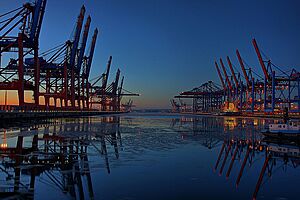
Hamburg is a major transportation hub. It is connected to four main highways. It is also an important railway junction for routes to Scandinavia. Bridges and tunnels connect the northern and southern parts of the city. These include the old Elbe Tunnel and the newer Elbe Tunnel.
Hamburg Airport is Germany's oldest airport still in use. It was built in 1912. There is also a smaller airport, Hamburg Finkenwerder Airport, used by Airbus.
Public Transportation
Public transport in Hamburg includes trains, buses, and ferries. It is all managed by the Hamburger Verkehrsverbund (HVV). One ticket works for all HVV services. The HVV was the first system of its kind in the world.
The S-Bahn (commuter trains) and U-Bahn (subway) are the main parts of the public transport system. The U-Bahn is mostly above ground or on embankments, not just underground. Buses fill in the gaps in the rail network. There are also eight ferry lines along the River Elbe. These are great for sightseeing too!
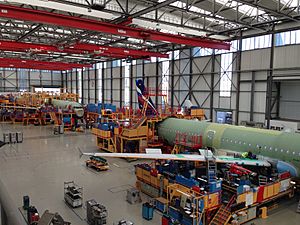
On average, people in Hamburg spend about 58 minutes commuting by public transport on a weekday. The average wait time at a stop is 11 minutes.
Learning and Education in Hamburg
Hamburg's school system is managed by the Ministry of Schools. In 2016, there were over 191,000 students in primary and secondary schools. The city also has 32 public libraries.
Hamburg has 19 universities with about 100,000 students. Six of these are public universities. The largest is the University of Hamburg. Others include the University of Music and Theatre and the Hamburg University of Applied Sciences. There are also private universities like the Bucerius Law School. The International School of Hamburg is one of Germany's oldest international schools.
Sports in Hamburg
Hamburg has a strong sports scene. Hamburger SV is a famous football (soccer) team. They have won the German championship six times. They play at the Volksparkstadion. Another popular football club is FC St. Pauli. They play at the Millerntor-Stadion.
Hamburg also has teams for other sports. The Hamburg Freezers used to play in Germany's top ice hockey league. HSV Handball was a top handball team. The Hamburg Towers are the city's main basketball team.
Hamburg is a capital for field hockey. Many top teams are from here. The city also hosts big sports events. These include the EuroEyes Cyclassics cycling race and the Hamburg Marathon. The Volksparkstadion was used for the 2006 World Cup.
Hamburg tried to host the 2024 Olympic Games. However, in a public vote, most residents voted against it. They felt it would cost too much public money.
Sister Cities
Hamburg has sister city relationships with several cities around the world:
 Saint Petersburg, Russia (1957)
Saint Petersburg, Russia (1957) Marseille, France (1958)
Marseille, France (1958) Shanghai, China (1986)
Shanghai, China (1986) Dresden, Germany (1987)
Dresden, Germany (1987) León, Nicaragua (1989)
León, Nicaragua (1989) Osaka, Japan (1989)
Osaka, Japan (1989) Prague, Czech Republic (1990)
Prague, Czech Republic (1990) Chicago, United States (1994)
Chicago, United States (1994) Dar es Salaam, Tanzania (2010)
Dar es Salaam, Tanzania (2010)
Famous People from Hamburg


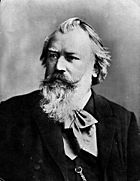
Many notable people were born in or lived in Hamburg, including:
- Barthold Heinrich Brockes (1680–1747), a German poet.
- Felix Mendelssohn (1809–1847), a famous German composer and pianist.
- Johannes Brahms (1833–1897), another renowned German composer.
- Heinrich Hertz (1857–1894), a physicist who proved the existence of electromagnetic waves.
- Helmut Schmidt (1918–2015), who served as the chancellor of West Germany.
- Angela Merkel (born 1954), who was the chancellor of Germany from 2005 to 2021.
- Olaf Scholz (born 1958), who was the First Mayor of Hamburg and is now the current chancellor of Germany.
Images for kids
See also
 In Spanish: Hamburgo para niños
In Spanish: Hamburgo para niños








